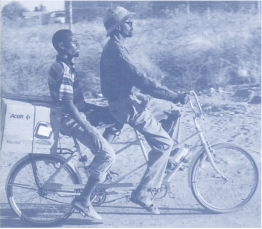ADOPTED BY
INTERNATIONAL ENVIRONMENTAL LAUREATES, European Environment Foundation
15 MARCH 2013
FREIBURG, GERMANY
We are greatly alarmed to be witnessing the development of several closely related, mutually compounding crises as a result of the global spread of materialism: a great imbalance in wealth and poverty, hunger and malnutrition, climate change, biodiversity losses, resource use and other ecological crises, financial crises, excessive military expenditure, public debt in many countries, and high (youth) unemployment.
Environmental degradation can now be increasingly observed in emerging economies, closely paralleling unsustainable developments in the industrial nations in the last century. This classic growth model based on excessive consumption has no future – neither globally nor for established industrialised countries. The development of a sustainable society must be our common goal. Based on the efficient use of energy and resources, the expansion of the education and knowledge sectors, green jobs (including low budget jobs), sustainable technologies and social innovations focusing on the common interest of people, this aim would meet people’s essential needs and safeguard prosperity worldwide, protecting the environment.
Any future for human civilization will build on justice as well as social and technological innovation. The current way that development and dissemination of technology is governed needs to change, to build on the basic tenet that everyone on the planet, not only today but including future generations, should have access to technology which enhances the quality of life.
Progress in international negotiations which aim to improve global conditions is, unfortunately, unsatisfactory and painfully slow. Nonetheless, these international processes must continue. Due to the worsening of climate change and the growing frequency and intensity of climate-related disasters, the international community needs to reach an agreement that will provide for effective measures of reducing greenhouse gas emissions to meet the agreed 2°Cmax goal before 2015 and implement it before 2020. The requisite instruments for tracking compliance are available now. The negotiations have long been generating important impetus for local; regional, national and international initiatives, and individual technological developments, but have not yet achieved global consensus. Parallel to the international negotiations, technological and action programs can and must be initiated at local, national, bilateral and international level.
The major opportunities afforded by a sustainable economy and the transformation of energy systems have still not been fully recognised. We call on governments and enterprises around the world to adopt strategies to improve energy efficiency, resource recovery and increase the share of renewable energy and implement renewable technologies in rural and remote areas.
2
We urge governments, enterprises, local authorities and individuals to take immediate action and to become pioneers of change and successful social innovation, and to galvanize younger generations, encouraging them to strive for their present and future rights.
We place our hopes in Coalitions of Winners. Such coalitions will
inspire equitable and informed societies and stimulate carbon-neutral economies
formulate positive goals towards a sustainable future,offering enough for all for ever,
set targets and provide focused support for technical and social innovation towards a sustainable future,
ensure that funding is channelled towards future-oriented markets,
utilise innovation to support sustainable livelihoods,
increase energy efficiency, drastically reduce fossil fuel and stop nuclear energy use and reduce greenhouse gas emissions through these endeavours,
introduce adequate legal and economic instruments to prevent ecological destruction and penalize overconsumption.
We propose the following specific strategies:
1. Universal access to modern energy services and formulation of positive targets for energy efficiency and renewable energy use -at least doubling the global rate of improvement in energy efficiency and doubling the share of renewable energy in the global energy mix by 2030the United Nations’ initiative on “Sustainable Energy for All” (SEFA) has proposed, or earlier.The progress should be monitored by an international agency.
2. Accelerated development and use of sustainable innovations of global significance in the sector of energy efficiency and renewable energies. Examples are highly energy-efficient buildings, electrical equipment, solar-powered cooling systems, solar-powered drinking water desalination, efficient public transport systems, zero-emission vehicles, high-efficient, low-cost renewable systems and storage technologies, especially products adapted to the needs of poor communities (e.g. simple renewable energy and water purification systems). Possible measures include the launch of international business competitions (a good example is Golden Carrot in the US, with awards and innovation targets, quality standards, environmental goals, maximum prices and minimum sales volumes) and highly effective market-stimulating feed-in tariffs started in Germany and adopted in more than 60 countries worldwide.
3. Funding and incentivizing innovation and infrastructural development using the following measures: abolition of environmentally harmful subsidies such as fossil fuel subsidies, implementation of financial transaction tax and green taxation (such as a CO2-tax), which must be accompanied by assistance for poor households, reductions in military spending including the abolition of nuclear weapons, and an exclusive focus on sustainable innovations and infrastructure in future economic stimulus programmes.
4. The acknowledgement by the planet’s leading corporations of the environmental and social impacts of their business practices, and their subsequent adoption of the systems and technologies necessary for a sustainable and equitable future.
We see the current critical situation as a failure of imagination. It is not the dream of a sustainable society that is unrealistic, but the blind belief that the status quo can be prolonged with marginal adjustments. Our call for action is about creating an inspiring future that is more ecologically secure and socially just than current policies can produce.
We therefore welcome the strongly increasing civil society initiatives. It is up to each and everyone to create the world that we are proud to pass on to future generations.




